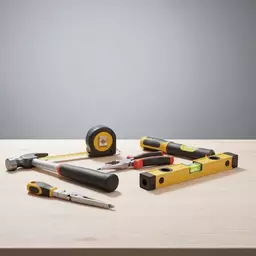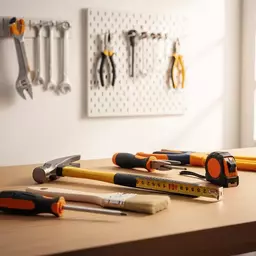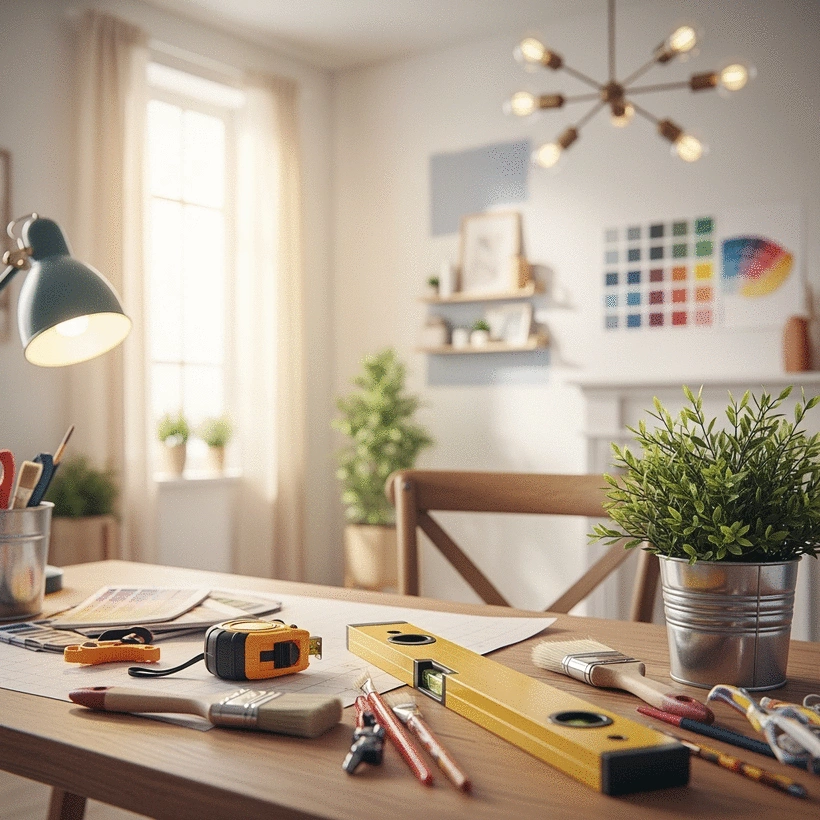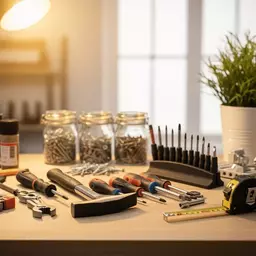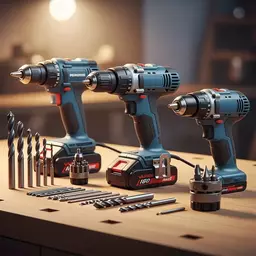Essential Power Tools for DIY
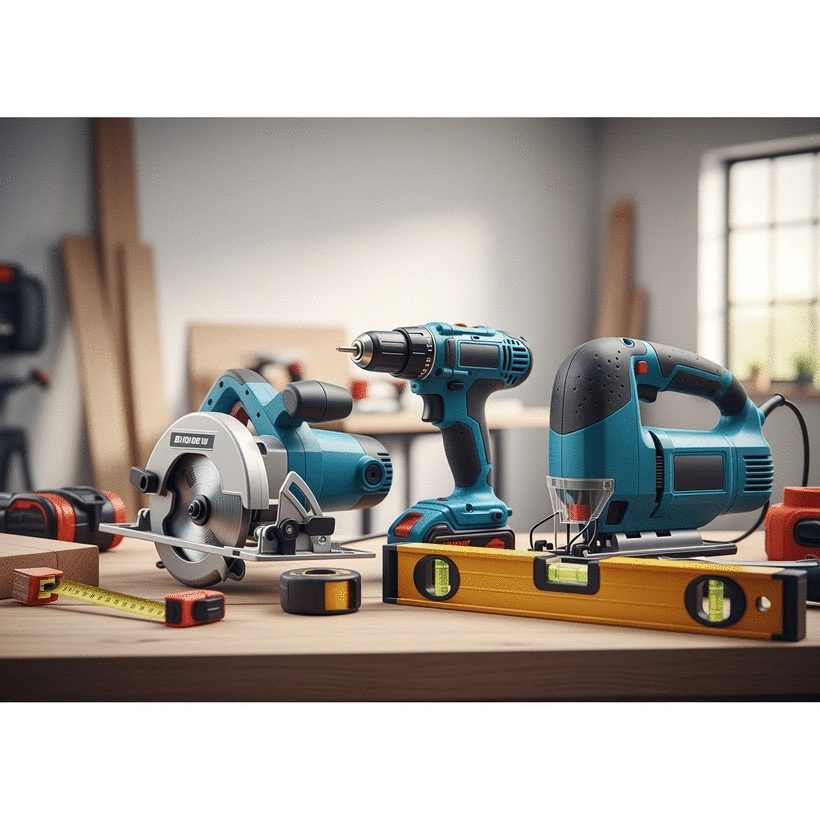
In the realm of DIY home projects, the right power tools can be the difference between a successful outcome and a frustrating experience. As you embark on your next project, consider how selecting the appropriate tools is essential for efficiency, safety, and quality.
What You Will Learn
- The right tools enhance efficiency and improve safety while working on DIY projects.
- Understanding your project's requirements helps you choose the specific tools needed for success.
- Regular maintenance and proper care of power tools extend their lifespan and ensure safety.
- Creating a custom tool kit tailored to your typical projects makes DIY tasks easier and more enjoyable.
- Choosing sustainable and ergonomic tools contributes to a safer working environment and reduces your carbon footprint.
Key Factors in Selecting Power Tools for DIY Projects
Understanding the importance of choosing the right tools can greatly impact your DIY experience. Below, you’ll find an engaging visual breakdown of the key factors and their impacts on DIY outcomes.
Efficiency
Get the job done quicker with the right tools, saving time and effort on your projects.
Quality
Achieve better finishes and results with tools designed for specific tasks.
Safety
Reduce the risk of accidents and injuries by using appropriate tools.
Durability
Quality tools last longer and perform better, reducing the need for replacements.
Essential Overview of Power Tools for DIY Home Projects
When diving into the world of DIY home projects, having the right power tools is crucial. Not only do they make tasks easier, but they can also significantly improve the quality of your work! At Hardware Store Guide, I’m here to help you navigate through the various tools you’ll need, ensuring that you feel equipped and confident as you tackle your projects.
Choosing the right tool can sometimes feel overwhelming, especially with so many options available. It’s essential to consider what you’ll be working on and the specific requirements of each project. Let's explore why selecting the right tools matters and how to define your DIY home projects effectively!
Understanding the Importance of Choosing the Right Tools
Having the right tools for your DIY tasks can make all the difference! Using tools specifically designed for each task not only increases efficiency but also enhances safety. If you’re working with heavy materials or complex designs, the right tools can prevent accidents and make the job more enjoyable.
Moreover, the right tools help you achieve professional results. Imagine trying to cut wood with a dull saw or using a drill that lacks power! By investing in quality power tools, you can ensure that your projects are completed smoothly. Here are some key reasons to choose wisely:
- Efficiency: Get the job done quicker.
- Quality: Achieve better finishes and results.
- Safety: Reduce the risk of accidents and injuries.
- Durability: Quality tools last longer and perform better.
Defining DIY Home Projects and Their Requirements
So, what exactly is a DIY home project? In simple terms, it’s any task you undertake to improve, repair, or create something in your home, all on your own! This could range from small repairs like fixing a leaky faucet to larger renovations, such as building a deck. Understanding what your specific project entails will help you determine the tools you'll need.
Each project has unique requirements, so here are a few common types and their tool needs to consider:
- Repair Projects: Basic hand tools, such as screwdrivers and pliers.
- Renovation Projects: Power tools like drills, saws, and impact drivers.
- Creative Projects: Specialty tools such as jigsaws for intricate designs.
- Landscaping Projects: Tools like electric lawnmowers and trimmers.
By accurately defining your project, you can ensure you’re well-prepared to tackle it head-on! Remember, each task presents a learning opportunity, and I’m here to guide you through the process every step of the way. With the right tools at your disposal, you can transform your home into a space you love.
Key Categories of Power Tools for Home Improvement
Now that we’ve covered the basics, let’s delve into the essential categories of power tools that will elevate your DIY experience!
Pro Tip
Before starting any DIY project, take a few moments to evaluate your workspace. A clean, organized area not only enhances your efficiency but also significantly reduces the risk of accidents. Consider designating specific zones for tools, materials, and completed tasks to keep everything in order!
Safety and Maintenance for Longevity of Power Tools
When diving into DIY projects, safety should always come first! Using power tools can be exciting, but it's important to know how to handle them properly to prevent accidents. Making safety a priority ensures that you not only enjoy your projects but also keep yourself and others safe during the process.
Here are some essential safety tips to keep in mind while using power tools:
- Always wear appropriate personal protective equipment (PPE), such as safety goggles, gloves, and ear protection.
- Before operating any power tool, it's crucial to read the user manual to understand its specific safety features and operating procedures.
- Keep your workspace tidy to avoid tripping hazards and ensure tools are stored properly when not in use.
- Never bypass safety guards or features; they’re designed to protect you! You can find a helpful power tool safety checklist from the CPSC.
- Make sure to disconnect power tools when changing bits or making adjustments.
Essential Safety Tips for Using Power Tools
It's easy to underestimate the importance of safety, but staying vigilant can make a huge difference. For instance, when I first began using power tools, I made it a habit to double-check my surroundings before starting. This simple practice helped me avoid accidents and keep my focus on the task at hand.
Additionally, always inspect your tools before use. Look for any signs of damage, such as frayed cords or loose parts, which could lead to malfunctions. Keeping your tools in good condition is key to ensuring not just safety, but also effective work! For more detailed guidance, refer to portable tool safety guidelines from LNI Washington.
Maintenance Practices to Extend Tool Lifespan
Just like we need regular check-ups, power tools benefit from consistent maintenance. Proper care not only ensures your tools perform well but can also save you money in the long run! Here are some straightforward maintenance practices to follow:
- Clean your tools after each use to prevent dust and debris buildup.
- Lubricate moving parts according to the manufacturer’s recommendations.
- Store tools in a dry place to prevent rust and corrosion.
- Regularly check batteries and replace them when necessary.
- Keep your tools organized in a dedicated toolbox to avoid damage.
Frequently Asked Questions About DIY Power Tools
- What are the most important factors to consider when choosing power tools for DIY projects?
- The most important factors include efficiency, quality, safety, and durability. Selecting tools that excel in these areas will lead to better project outcomes and a safer working environment.
- Why is safety so crucial when using power tools?
- Safety is paramount to prevent accidents, injuries, and damage to property. Proper use of PPE, reading manuals, and maintaining a tidy workspace are essential for safe operation.
- How can I extend the lifespan of my power tools?
- Regular maintenance, such as cleaning after each use, lubricating moving parts, storing tools in a dry place, and checking batteries, can significantly extend their lifespan.
- What should I include in a custom tool kit for home improvement?
- A custom tool kit should be tailored to your frequent projects. Start with essentials like a hammer, tape measure, and screwdrivers, then add specialized tools such as a miter saw for woodworking or a trowel for gardening, based on your needs.
- How do environmental and ergonomic considerations impact tool selection?
- Choosing sustainable tools (e.g., Energy Star rated, battery-operated) reduces your carbon footprint. Ergonomic designs, like cushioned grips and adjustable handles, enhance user comfort, reduce fatigue, and improve precision during long projects.
Creating Custom Tool Kits for Your Projects
Building your own custom tool kit can transform your DIY experience! Having the right tools at your fingertips not only saves time but also boosts your confidence when tackling various projects. Think of it as your personalized toolbox tailored to your unique needs.
When creating a tool kit, consider the types of projects you frequently undertake. For example, if you enjoy woodworking, you'll want to include specific tools like a miter saw, clamps, and chisels. On the other hand, if home repairs are your focus, a reliable set of screwdrivers, pliers, and a stud finder would be essential additions.
How to Build a Tailored Tool Kit for Home Improvement
Here’s a simple guideline to help you build your very own tailored tool kit:
- Assess the types of projects you want to work on—this will help determine your core tools.
- Start with a basic set of essential tools, such as a hammer, tape measure, and level.
- Gradually add specialized tools as needed, based on specific tasks or projects.
- Consider the quality of tools over quantity; investing in good quality will pay off!
Recommended Tool Kits for Specific DIY Tasks
At Hardware Store Guide, I've seen many tool kits that cater to different DIY tasks. Here are a few recommendations that I’ve found particularly useful:
- Basic Home Repair Kit: Includes a hammer, screwdrivers, pliers, and a tape measure.
- Woodworking Kit: Contains a miter saw, chisels, clamps, and sandpaper.
- Painting Kit: Features brushes, rollers, painter's tape, and drop cloths.
- Gardening Kit: Comprises a trowel, pruners, gloves, and a weeder.
Environmental and Ergonomic Considerations in Tool Selection
Being a DIY enthusiast also means being mindful of the environment. Choosing power tools that are eco-friendly can make a big difference in reducing our carbon footprint while enjoying our projects! Plus, ergonomic design not only contributes to sustainability but also enhances your comfort during use.
Choosing Sustainable Tools for Eco-Friendly Projects
When shopping for tools, consider looking for those that are energy-efficient or made from sustainable materials. Some tips to find sustainable options include:
- Look for tools with Energy Star ratings.
- Choose brands that prioritize eco-friendly practices and materials.
- Consider rechargeable battery-operated tools to reduce waste.
Importance of Ergonomic Design for User Comfort
Having tools that are designed with ergonomics in mind can really make your DIY experience more enjoyable. Tools that are comfortable to hold and use help reduce fatigue and strain, allowing you to work longer and with greater precision. When browsing for tools, keep an eye out for features like cushioned grips and adjustable handles!
Final Thoughts on Selecting the Best Power Tools
As we wrap up our exploration of power tools, it's worth revisiting the key features to look for. From safety and maintenance to creating a custom tool kit and being environmentally conscious, every aspect contributes to a fulfilling DIY experience. Remember, the right tools can empower you to embark on projects with confidence!
Now it’s your turn! If you're ready to take on your next DIY project, gather your tools, and let your creativity shine. Don’t forget to check back with Hardware Store Guide for more tips and insights on maximizing your local hardware store experience!
Recap of Key Points
Here is a quick recap of the important points discussed in the article:
- Importance of Choosing the Right Tools: Enhance efficiency, quality, safety, and durability in your DIY projects.
- Defining Your DIY Projects: Understand project types to determine necessary tools, from repairs to renovations.
- Safety First: Always wear PPE, read user manuals, and maintain a tidy workspace to prevent accidents.
- Maintenance Matters: Regularly clean, lubricate, and store tools properly to extend their lifespan.
- Creating Custom Tool Kits: Tailor your tool kit to your specific project needs for efficiency and confidence.
- Environmental Considerations: Choose sustainable and ergonomic tools to reduce your carbon footprint and enhance comfort.
